Project details
Skill
Cost
Estimated Time
We may be compensated if you purchase through links on our website. Our team is committed to delivering honest, objective, and independent reviews on home products and services.
Doors that stick are a major pain. Whether it’s a bedroom door that won’t close properly or an exterior door that’s difficult to open, a sticking door can cause day-to-day disruptions and even damage if left unaddressed. Our guide explains how to diagnose and fix a door that sticks so you can get it back in working order.
Understanding Why Doors Stick
Doors in your home can stick for various reasons.
Seasonal Changes and Humidity
One of the most common reasons doors stick is due to seasonal changes and fluctuations in humidity. Wood is a natural material that expands when it absorbs moisture and contracts when it dries out. This seasonal swelling can cause doors to fit tightly in their frames during humid summer months, leading to sticking.
Structural Issues
Sometimes, sticking doors can be a sign of more serious structural problems. Foundation settling, warped door frames, or improperly installed doors can all lead to alignment issues that cause sticking. These problems may require more extensive repairs or professional intervention.
Tools and Materials Needed to Fix a Sticking Door
Most of the tools you’ll need to fix a sticking door are likely things that you already have in your toolbox, but if you don’t frequently work with wood, you might not have items like a chisel or planer.
Essential Tools
- Screwdriver (flathead and Phillips)
- Hammer
- Wood chisel (¾-inch)
- Jack plane or hand plane
- Sandpaper (medium and fine grit)
- Paintbrush
- Measuring tape or ruler
Optional Equipment
Depending on the specific issue with your door, additional tools and materials might be needed:
- Power planer (for larger jobs)
- Dehumidifier (for moisture-related issues)
- Wood filler or wood glue (for repairing stripped screw holes)
- Paint and primer (matching the door’s current color)
Step 1: Close Shave
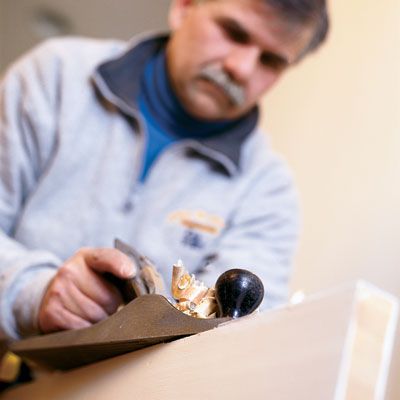
Tom Silva’s general rule for keeping a door from sticking in the jamb is that the reveal—the space between the door and jamb—should be 1/8 to 3/16 inch wide, or about the thickness of a nickel.
Examining one sticky bedroom door in his house, Silva spends a little time getting a sense of its predicament. He opens and closes it to see where it catches, and he eyeballs the reveal. An uneven reveal may mean the hinges are loose or out of alignment. And, in fact, the screws holding the top hinge to the jamb have stripped their holes, causing the door to sag. But after fixing them, Silva finds that the door still sticks. Satisfied that humidity is the culprit, he pulls the hinge pins, lifts the door from the jamb, and gets ready to plane.
Step 2: Check for a Loose Hinge
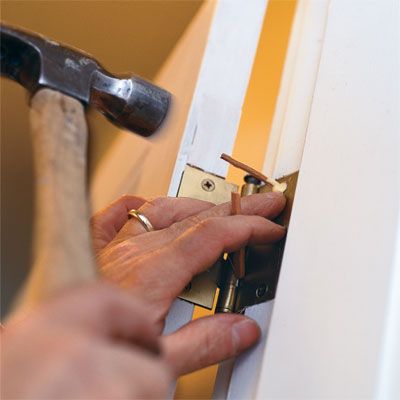
To repair a stripped screw hole under the hinge leaf, Silva plugs the hole and gives the screw something new to bite into. He whittles a 1/4-inch-wide, slightly tapered splinter out of a scrap of wood, then squeezes wood glue onto it and into the screw hole. He taps in the plug with his hammer, and glue oozes out of the hole. “You don’t want to have a dry spot,” Silva says, as he wipes away the excess, “or you won’t get good adhesion.” He snaps the protruding sliver flush with the hinge leaf. With the glue still wet, he refastens the hardware, cinching the screw tight.
Step 3: Deepen the Hinge Mortises
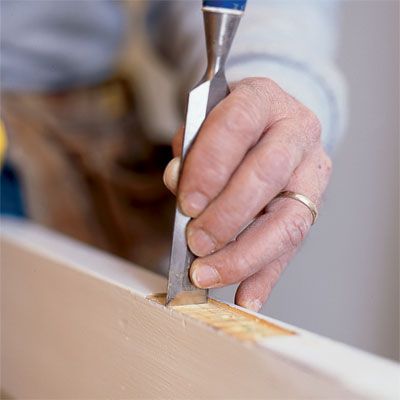
After repairing the hinge, Silva sees that the door is still too big to close smoothly; he has no choice but to plane it to fit. To avoid disassembling the doorknob, he’ll take the excess off the hinge side.
First, he removes the hinges so he can chisel their mortises 1/8 inch deeper—the same amount he will plane from the door’s edge. Holding a 3/4-inch chisel vertically in the mortise, he hammers a dozen or so parallel 1/8-inch-deep cuts across the width of the mortise and one long cut against its inside edge. Then he leans his weight on the chisel—bevel side up—and rocks it gently back and forth, plowing out the chips of wood. He repeats the process on the other mortise.
Step 4: Plane the Door
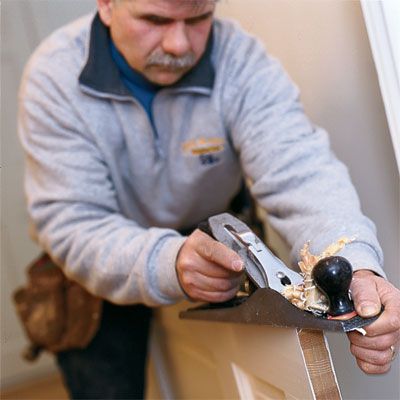
Silva knows that cutting through the layers of paint on this old door means he’ll likely have to sharpen the plane’s blade, called an iron, when the job is done. Luckily, the finish is lead-free, so slicing through it will not send hazardous particles flying. “If it were lead paint, I’d first want to use a chemical stripper,” he says.
Curls of pine tumble to the floor as he runs the plane at a slight angle in long, smooth strokes along the length of the door. The plane iron leaves the edges sharp, so Silva rounds them slightly with some sandpaper to help them better accept paint.
In the video below, general contractor Silva demonstrates how to use a hand plane.
Step 5: Paint the Raw Wood
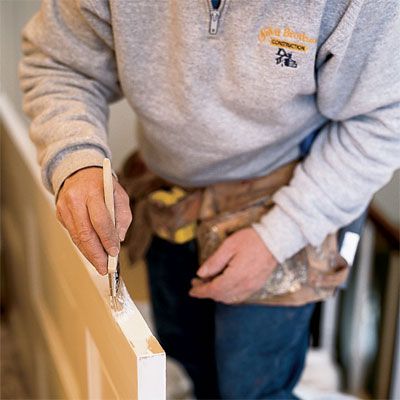
Before he goes any further, Silva slides each hinge leaf into its mortise to make sure the metal is flush with the door’s edge. Then he pops the hinges back out and reaches for his paintbrush. “It’s important to get the wood primed and painted as soon as possible,” Silva says, because it will slow the creep of moisture. Otherwise, the door will swell again almost immediately, and “you’ll be right back where you started.” He brushes on a primer coat, then a finish coat, carefully blending the new paint into the old without dripping down the face of the door.
Step 6: Rehang the door

Once the paint has dried, Silva reattaches the hinge leaves. Then he hoists the door back into its opening, lining up the knuckles and dropping in the pins—first top, then bottom. Using the handle of his screwdriver, Silva taps each pin home and then gives the door a test swing. It obligingly snaps shut, and the latch clicks cleanly into its strike plate. When Silva turns the doorknob and gives a gentle tug, it opens without resistance.
Dealing With Swollen Wood
In cases where humidity is causing the door to swell, you may need to take additional steps to address moisture issues. Here are some options.
Using a Dehumidifier
Place a dehumidifier near the problem door to reduce ambient moisture. This can help shrink the swollen wood and alleviate sticking. A dehumidifier can be a great solution for temporary humidity issues.
Applying Moisture Sealant
Consider applying a moisture-resistant sealant to the edges and bottom of the door to help prevent future swelling. This is particularly useful for exterior doors or those in high-humidity areas like bathrooms. Moisture sealants offer a long-term solution to humidity-related sticking.
Preventive Measures
Taking proactive steps can help prevent doors from sticking in the future and reduce the need for repairs. Periodically check and tighten hinge screws, clean and lubricate the hinges annually, and inspect and replace weather stripping on exterior doors.
Maintain consistent indoor humidity levels, ideally between 30% and 50%, to minimize wood swelling. Use air conditioners, dehumidifiers, or humidifiers as needed to regulate moisture in your home.
When To Call a Professional
While many sticking door issues can be resolved with DIY methods, some situations may require professional expertise. If you suspect that your sticking door is a symptom of foundation problems or significant structural issues, consult a professional contractor or structural engineer.
For older homes with historical value, it’s often best to consult a specialist who can fix a rubbing door without compromising its historical integrity. These experts can also address unique challenges posed by antique hardware or nonstandard door sizes.

